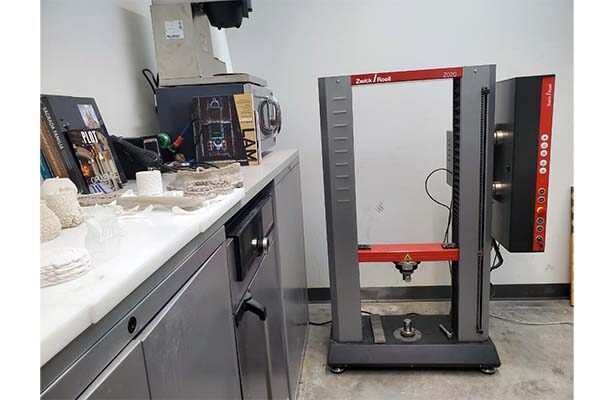Creative Spaces
Advanced Building Construction (ABC) Lab
The ABC Lab offers Spitzer students access to knowledge and tools necessary for research in the field of building technology.
The production of materials for building construction consumes billions of tons of natural resources every year. Reducing resource usage without diminishing a material’s mechanical behavior is the heart of our research. At ABC Lab, we explore new methods of structural form-finding used to design efficient structures on small and large scales. We also investigate natural resources and building methods to provide structural solutions that result in low carbon emission and reduced environmental impact.
The ABC Lab anticipates the future of construction in New York City by investing in two main ideas of robotic fabrication and carbon-negative building materials. The entrepreneurial mindset of the center is to invest in carbon dioxide (CO2) absorption of buildings that will soon be mandated by the government. In addition, ABC Lab has been established based on demonstrable educational and research value for our students.
Space for teaching
Observation and hands-on experiences in a precisely designed laboratory framework enhance student understanding of a concept, scientific theory, or fact in action. Some building technology courses require more technical knowledge than others, and in those classes, most concepts can be best illustrated by simple experiments integrated into lectures to develop scientific reasoning. ABC Lab will foster student interest in the subject matter by linking course content to the real world. “Interacting with the unconstrained environment of the material world in laboratory experiences may help students concretely understand the inherent complexity and ambiguity of natural phenomena. Laboratory experiences may help students learn to address the challenges inherent in directly observing and manipulating the material world, including troubleshooting equipment used to make observations, understanding measurement errors, and interpreting and aggregating the resulting data” (America’s Lab Report).
Space for construction
Materials such as foam, plastic, fabric, glass, and wood are used significantly for model-making in our school. On the other hand, students do not have much experience working with masonry materials such as ceramic, stone, and concrete. Exposure to these materials and the complex building methods will help students discover material potential. Experimentation will allow critical imagination, research endeavors, and practical understanding of our students to flourish.
Space for research
ABC Lab endeavors to bridge the gap between sustainable construction materials, design, and structural engineering. Here, interdisciplinary research groups work toward the advancement of materials, computational methods, and novel structural design techniques. The main aim of the lab is to integrate structural performance into the design and development of ultra-lightweight, eco-friendly construction materials at macro and micro scales. Our research, focused on enhanced building materials and methods through the lens of sustainability, is imperative considering conventional buildings’ impact on the environment. The ABC Lab:
- allows students and researchers to investigate the mechanical behavior of efficient structures with more scientifically accurate results to support the research in the design of high-performance structural components for application in building and infrastructure industries;
- extends the research in the design and utilization of enhanced and sustainable materials that can change the face of structures;
and thus represents our school as a frontier in research of innovative, high-performance materials and structures.
ABC Lab available equipment
- Clay 3d Printer, 3D PotterBot 10 Micro: 1000ml extruder
- Concrete 3D Printer, 50 Pump: 24V 10 amps, 240 Watt Main controller board running Duet3D with Atmel SAM4E8E: 120MHz ARM Cortex-M4
- 3D Potterbot Scara v4
- Raise3D Pro2 Plus fully enclosed 3D printer: 12 x 12 x 23.8” in build volume
- Zwick/Roell Proline Universal machine, 2 kN
- Welder: PrimeWeld MIG180 Mig Welder, 180 Amp
- Wet sliding table tile saw: Kobalt 7in, 10Amp
- Form-tech Vacuum machine
- Concrete mixer: Bench top lab mixer, 5 Qt. (ASTM C305)
- Grout mixer: Rotary
- 1 kip compression machine
- 6-gallon cable air compressor
- Torque wrench: 1/2 inch drive electronic
Advanced Building Construction (ABC) Lab
Room 004
For access and more information contact:
Damon Bolhassani








